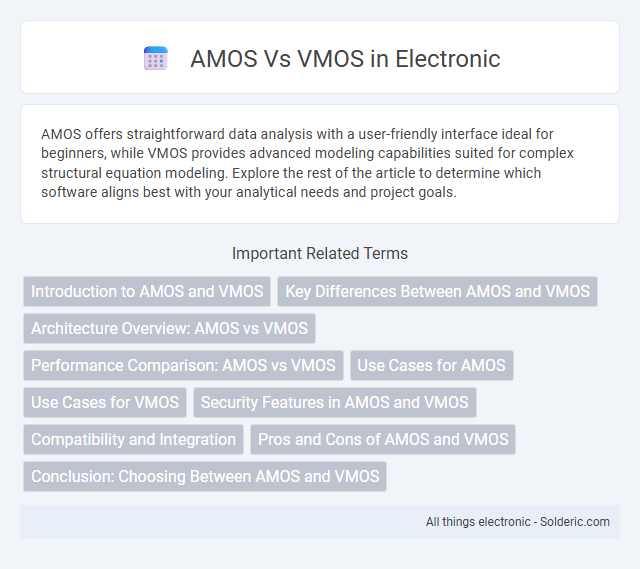AMOS offers straightforward data analysis with a user-friendly interface ideal for beginners, while VMOS provides advanced modeling capabilities suited for complex structural equation modeling. Explore the rest of the article to determine which software aligns best with your analytical needs and project goals.
Comparison Table
| Feature | AMOS | VMOS |
|---|---|---|
| Platform Type | Android Modding Tool | Android Virtual Machine (Dual OS) |
| Main Function | Modify and customize Android system files | Run a virtual Android environment within Android |
| Use Case | System tweaks, custom ROM installation | App sandboxing, multi-account, testing apps |
| Root Requirement | Typically requires root access | No root required |
| Performance Impact | Directly modifies host system, minimal overhead | Runs virtual OS, may cause slight performance lag |
| Supported Devices | Compatible with rooted Android devices | Compatible with most Android devices (no root) |
| Security | Depends on user modifications | Isolated virtual environment enhances security |
| User Interface | System-level tweaking tools and menus | User-friendly virtual OS interface |
Introduction to AMOS and VMOS
AMOS and VMOS are advanced virtual machine operating systems designed for mobile devices, enabling users to run multiple OS environments simultaneously. AMOS specializes in resource-efficient virtualization tailored for Android applications, while VMOS offers a robust virtual Android environment compatible with a wide range of apps and customization options. Both platforms enhance multitasking and app compatibility by creating isolated virtual spaces within a host device.
Key Differences Between AMOS and VMOS
AMOS operates as a research-based calibration tool mainly for automotive electronic control units, enhancing ECU programming precision, while VMOS functions as a virtual machine operating system enabling app virtualization and multitasking on Android devices. Unlike AMOS, VMOS supports running multiple Android instances simultaneously, offering a sandbox environment for testing apps without affecting the host system. AMOS integrates deeply with automotive software development workflows, whereas VMOS targets mobile users seeking enhanced app management and virtualization capabilities.
Architecture Overview: AMOS vs VMOS
AMOS architecture is built on a lightweight microkernel design, emphasizing modularity and real-time responsiveness ideal for embedded systems. VMOS, by contrast, employs a virtual machine architecture that allows multiple Android instances to run simultaneously on a single device, leveraging hardware virtualization for isolation and flexibility. This fundamental difference results in AMOS prioritizing direct hardware interaction and efficiency, while VMOS focuses on virtualization and multi-environment support.
Performance Comparison: AMOS vs VMOS
AMOS offers a lightweight virtual machine environment optimized for seamless multitasking and system resource management, delivering faster app launch times and smoother user experience. VMOS, while more feature-rich with its support for running a full Android system on top of another, tends to consume more CPU and RAM, potentially causing slower performance on lower-end devices. Benchmark tests reveal AMOS achieves higher frame rates and reduced latency during intensive tasks compared to VMOS, making it preferable for performance-critical applications.
Use Cases for AMOS
AMOS excels in satellite operations management, providing robust scheduling, monitoring, and control functionalities for space agencies and commercial satellite operators. It supports mission planning, telemetry processing, and ground station automation, making it ideal for complex constellation management and real-time data analysis. Organizations leveraging AMOS benefit from enhanced operational efficiency, reduced downtime, and improved satellite resource allocation.
Use Cases for VMOS
VMOS excels in use cases requiring app cloning and virtual environments, enabling users to run multiple instances of social media, gaming, or messaging apps simultaneously without interference. It is highly suitable for developers and testers who need to simulate different Android versions on one device to verify app compatibility. VMOS also supports root access within the virtual machine, making it ideal for experimenting with apps that need elevated permissions without risking the host system.
Security Features in AMOS and VMOS
AMOS offers robust security features including encrypted data storage and real-time threat detection, ensuring your device's safety from malware and unauthorized access. VMOS, on the other hand, provides a secure virtual environment with sandboxing capabilities that isolate apps, preventing potential security breaches from affecting the host system. Both platforms prioritize user protection but utilize distinct methods: AMOS emphasizes integrated security tools, while VMOS relies on virtualization for enhanced app isolation.
Compatibility and Integration
AMOS offers extensive compatibility with various flight controllers and simulation software, ensuring seamless integration in professional drone systems. VMOS excels in mobile device environments, providing robust support for Android and iOS gaming and app virtualization. Your choice depends on whether you prioritize drone system integration or mobile app compatibility for smooth operation.
Pros and Cons of AMOS and VMOS
AMOS offers native app performance with deep system integration, providing faster response times and efficient resource management but requires complex development and limited multi-instance support. VMOS enables running multiple Android instances simultaneously, allowing app cloning and custom OS environments, which is ideal for testing and multitasking but can lead to higher CPU usage and slower performance. Choosing between AMOS and VMOS depends on the need for native efficiency versus flexibility in virtualized environments.
Conclusion: Choosing Between AMOS and VMOS
Selecting between AMOS and VMOS depends on specific user requirements and device compatibility. AMOS excels in advanced statistical modeling and data processing for specialized research applications, while VMOS offers a versatile virtual machine environment conducive to running multiple operating systems and apps simultaneously. Opting for AMOS suits data scientists needing robust analytics, whereas VMOS appeals to users seeking flexible app management on a single device.
AMOS vs VMOS Infographic

 solderic.com
solderic.com